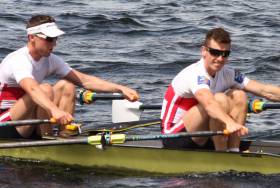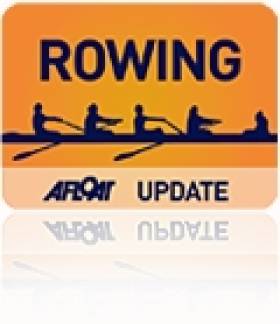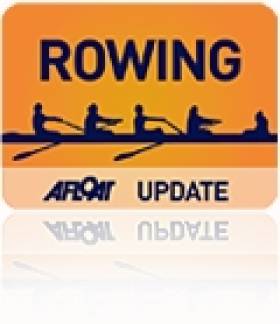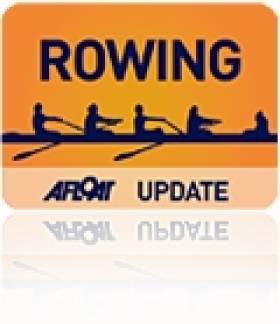Displaying items by tag: Assessment
Mark O'Donovan Faster Than Gary O'Donovan at Rowing Trial (Update)
#Rowing: Mark O’Donovan was first and Shane O’Driscoll second at the Ireland Assessment at the National Rowing Centre today – ahead of Olympic medallist Gary O’Donovan, who was the third-fastest lightweight and fourth overall. Heavyweight competitor Sam McKeown, who recently broke six minutes for 2,000 metres on the ergometer, was third and Daire Lynch, who is just moving out of junior ranks, an impressive fifth. The tests were run over six kilometres. Paul O’Donovan, the top lightweight, has exams and did not attend.
The top woman was Sanita Puspure, with Denise Walsh almost a minute further back. The women’s pair of Aifric Keogh and Aoife Feeley won their battle with the under-23 unit of Amy Mason and Tara Hanlon, but by a small margin.
Irish Assessment, National Rowing Centre (Selected Results; Six Kilometres)
Saturday
Men
Single Sculls – Heavyweight: 1 S McKeown 23 mins 57 seconds, 2 D Lynch 24:15, 3 T Oliver 24:17. Lightweight: 1 Mark O’Donovan 23:53, 2 S O’Driscoll 23:56, 3 G O’Donovan 24:09.
Women
Single Sculls – 1 S Puspure 25:12, 2 D Walsh 26:07, 3 A Keogh, A Feeley (pair) 26:25, 4 T Hanlon, A Mason (u23 pair) 26:28, 5 E Hegarty 27:05.
Sunday
Men: 1 S McKeown, T Oliver 21:29. Women: Four 24:01, 2 Puspure 25:18, 3 Walsh 26:06, 4 Pair 26:50.
McKillen Sets Excellent Time at Rowing Ireland Trial
# ROWING: Adam Boreham of Belfast Boat Club, a heavyweight under-23 athlete, topped the rankings in ergometer (rowing machine) times on the first day of the Rowing Ireland Assessment in Newry today. Justin Ryan of Skibbereen was the fastest lightweight, with a time of six minutes 14 seconds, seven seconds slower than Boreham for the 2,000 metres. Gareth McKillen of RBAI topped a very competitive junior grade, clocking a remarkable six minutes 22 seconds.
The fastest woman was Sanita Puspure, clocking 6:40.5, and junior athlete Bridget Jacques clocked 7:04.4. The fastest lightweight was under-23 athlete Denise Walsh. Claire Lambe and Siobhan McCrohan were exempted on sick notes.
Tomorrow’s time trial on Newry Canal, scheduled for 11 o’clock, has been brought forward at least a half an hour because of concerns about the weather.
| Rowing Ireland |
|---|
| Newry Assessment |
| 2K Erg Test Results - 9th February 2013 - OVERALL |
| Category Time |
| Adam Boreham HM U23 06:07.0 |
| David Neale HM 06:09.5 |
| Matthew Wray HM U23 06:10.7 |
| Jonathon Mitchell HM U23 06:11.9 |
| Justin Ryan LM 06:14.0 |
| Fionnan McQuillan-Tolan HM U23 06:15.2 |
| Sean O Connor HM U23 06:18.1 |
| Colm Keenan HM 06:18.4 |
| Niall Kenny LM 06:18.4 |
| Gareth McKillen JM 06:22.0 |
| Paul O'Donovan LM U23 06:22.8 |
| Paddy Hegarty JM 06:23.5 |
| Andy Harrington JM 06:24.6 |
| Jack Casey JM 06:24.9 |
| Gary O'Donovan LM U23 06:25.0 |
| Shane O'Driscoll LM U23 06:25.1 |
| Alan Prendergast LM U23 06:33.1 |
| Aodhan Burns LM U23 06:34.1 |
| Eoghan Whittle JM 16 06:34.8 |
| Aidan Kinneen JM 06:35.9 |
| James Egan JM 06:35.9 |
| Jack Silke JM 06:37.5 |
| Conor Camody JM 06:37.9 |
| Kai McGlacken JM 16 06:38.2 |
| Andrew Bell LM U23 06:38.8 |
| David O Malley JM 06:38.9 |
| Brian Keohane JM 06:39.2 |
| Sam Keogh JM 06:39.3 |
| William Yeomans JM 06:39.7 |
| Sanita Puspure HW 06:40.5 |
| Daniel Buckley JM 06:41.1 |
| James Blackwell JM 06:41.8 |
| Philip McCullough JM 06:42.5 |
| Rory O Sullivan JM 06:42.9 |
| Matthew Ryan JM 06:43.6 |
| Karl Anderson JM 06:43.6 |
| Eoghan Fogarty JM 06:44.9 |
| John Mitchel JM 06:46.8 |
| David Keohane JM 06:47.4 |
| Aidan Murray JM 16 06:48.0 |
| Neil McCarthy JM 06:48.2 |
| Evan Stone JM 06:48.4 |
| Kevin Keohane JM 06:49.0 |
| Kevin Fallon JM 06:49.3 |
| Evan Despard JM 06:49.3 |
| Ewan Murry JM 06:49.4 |
| Charlie Murray JM 06:49.5 |
| Ger McNamera JM 06:49.5 |
| Christopher Laffey JM 06:50.0 |
| Jack Smyth JM 06:51.7 |
| Patrick Munnelly JM 16 06:52.4 |
| Thomas Cregan JM 16 06:54.8 |
| Eoghan O'Connor LM U23 06:55.3 |
| Mark Breen JM 06:56.4 |
| Ewan Gallagher JM 16 06:57.2 |
| Monika Dukarska HW 06:57.8 |
| Kevin Hogan JM 16 06:57.8 |
| Alex Chadfield JM 06:59.3 |
| Nathan O Reilly LM U23 07:00.3 |
| Mike O'Hanlon JM 16 07:02.1 |
| Andrew GOFF JM 16 07:02.8 |
| Colin Finnrty JM 16 07:03.3 |
| Eoghan Walls JM 16 07:03.8 |
| Bridget Jacques JW 07:04.4 |
| Hilary Shinnick JW 07:05.6 |
| Stephen Murphy JM 07:07.6 |
| Erin Barry JW 16 07:10.8 |
| Jasmin English JW 07:15.5 |
| Clodagh Scannell JW 07:26.8 |
| Denise Walsh LW U23 07:26.9 |
| Fiona Murtagh JW 07:27.3 |
| Hannah McCarthy JW 07:30.1 |
| Phoebe Mulligan JW 07:30.7 |
| Leonie Hamel JW 07:31.9 |
| Claire Beechinor JW 16 07:32.1 |
| Sinead Dolan LW U23 07:33.6 |
| Sarah Dolan LW 07:33.8 |
| Amy Bulman LW 07:34.3 |
| Zoe Hyde JW 16 07:34.4 |
| Megan Blackburne JW 07:34.8 |
| Eimear Lambe JW 16 07:36.4 |
| Ruth Gilligan JW 07:40.5 |
| Daisy Callanan JW 07:40.9 |
| Elizabeth Clarke JW 16 07:41.8 |
| Kara O Connor JW 16 07:41.9 |
| Aisling Rodger JW 07:42.2 |
| Kirstie Turner JW 07:43.8 |
| Lauren McHugh JW 07:44.2 |
| Sally O Brien LW U20 07:47.0 |
| Megan McLaughlin JW 07:47.1 |
| Sarah Murphy JW 16 07:54.0 |
Lightweights Top Rankings at Rowing Assessment
| Rowing Ireland |
|---|
| Results Time Trial 26th November 2011 |
| Values |
| Row Labels Time %GMT |
| HM1x |
| Colin Williamson (QUBBC) HM 20:29.7 79.7% |
| David Neale (UCD ) HM 21:01.6 77.7% |
| BHM1x |
| Eddie Mullarkey (NUIGBC) HMU23 21:11.9 78.2% |
| Patrick Hughes (DUBC) HMU23 21:37.8 76.7% |
| Finbarr Manning (UCD ) HMU23 21:44.7 76.3% |
| Matthew Wray (Bann RC) HMU20 22:51.2 72.6% |
| LM1x |
| Mark O'Donovan (CITRC) LM 20:21.6 81.9% |
| Anthony English (UCCRC) LM 20:42.3 80.5% |
| Nathan O'Reilly (Tideway Scullers School) LM 21:10.1 78.7% |
| Niall Kenny (NUIGBC) LM 21:17.4 78.3% |
| Colm Dowling (Lee Valley R.C.) LM 21:34.0 77.3% |
| BLM1x |
| Justin Ryan (UCCRC) LMU23 20:54.0 81.7% |
| Shane O'Driscoll (CIT) LMU23 21:00.3 81.3% |
| Jonathan Mitchell (QUBBC) LMU23 21:03.6 81.1% |
| Adam O'Donohue (Carlow RC) LMU23 22:08.0 77.2% |
| Colin Barrett (UCD ) LMU23 22:42.1 75.3% |
| HW1x |
| Sanita Puspure (OCBC) HW 21:48.7 81.2% |
| BHW1x |
| Holly Nixon (Portora BC) HWU20 22:22.2 81.0% |
| Monika Dukarska (Killorglin RC) HWU23 22:48.4 79.5% |
| LW1x |
| Siobhan McCrohan (Tribesmen RC) LW 22:06.2 82.9% |
| BLW1x |
| Claire Lambe (UCDBC) LWU23 22:29.8 83.5% |
| Sinead Dolan (DULBC) LWU23 23:31.8 79.9% |
| Aoife Leahy (St Michaels) LWU20 24:12.5 77.6% |
| JW1x |
| Hilary Shinnick (Fermoy RC) WJ17 23:31.8 79.0% |
| Bernadett Walsh (Skibbereen R.C.) WJ17 23:33.2 78.9% |
| Bridget Jacques (BBC) WJ17 23:37.2 78.7% |
| Kate O'Brien (St Michaels) WJ18 23:53.4 77.8% |
| Sally O'Brien (Neptune R.C.) WJ18 23:54.9 77.7% |
| Katie Cromie (Portora BC) WJ18 23:55.2 77.7% |
| Fionna Murtagh (GRC) WJ17 24:00.3 77.4% |
| Megan McLaughlin (Cork BC) WJ16 24:06.7 77.1% |
| Sarah Higgins (Cork BC) WJ18 24:11.9 76.8% |
| Laura Connelly (Skibbereen R.C.) WJ18 24:16.0 76.6% |
| Sarah Allen (Bann RC) WJ18 24:16.9 76.5% |
| Eimear Byrne (Neptune R.C.) WJ18 24:19.9 76.4% |
| Sadhbh Cassidy (Neptune R.C.) WJ18 24:24.0 76.2% |
| Phoebe Mulligan (Portora BC) WJ17 24:35.3 75.6% |
| Roisin Merz (Shandon B.C.) WJ18 24:35.5 75.6% |
| Hanna O'Sullivan (St Michaels) WJ18 24:36.0 75.5% |
| Ruth Gilligan (Shannon RC) WJ17 24:42.8 75.2% |
| Jasmine English (MCB) WJ16 24:50.9 74.8% |
| Laura Coleman (Shandon B.C.) WJ18 24:56.8 74.5% |
| Lucie Litvack (BBC) WJ18 24:57.1 74.5% |
| Katherine Cremin (Muckross RC) WJ16 24:57.3 74.5% |
| Lauren McHugh (Shannon RC) WJ17 25:00.4 74.3% |
| Megan Donnegan (Castleconnell Boat Club) WJ17 25:01.3 74.3% |
| Aileen Crowley (Muckross RC) WJ18 25:02.2 74.2% |
| Claire Silke (Castleconnell Boat Club) WJ16 25:02.8 74.2% |
| Emily Hutchinson (Bann RC) WJ18 25:11.0 73.8% |
| Ella Ciallis (Skibbereen R.C.) WJ18 25:16.5 73.5% |
| Kara O'Connor (Muckross RC) WJ16 25:18.3 73.4% |
| Laura Kilbane (Cork BC) WJ16 25:18.8 73.4% |
| Claire Beechinor (Cork BC) WJ16 25:20.4 73.3% |
| Megan Donnelly (GRC) WJ16 25:26.6 73.0% |
| Kellie Wade (GRC) WJ17 25:27.2 73.0% |
| Zoe Hyde (Killorglin RC) WJ16 25:34.2 72.7% |
| Hanna McCarthy (St Michaels) WJ17 25:40.2 72.4% |
| Ruth Cummins (GRC) WJ16 25:49.9 71.9% |
| Meabh O'Brien (GRC) WJ16 26:47.1 69.4% |
| Cara Cunningham (GRC) WJ17 27:10.3 68.4% |
| Rebecca McKeown (BBC) WJ18 27:18.6 68.0% |
| Brooke Edgar (Bann RC) WJ18 27:39.4 67.2% |
Big Margin for O'Donovan in Newry Rowing Assessment
#ROWING–Paul O’Donovan was by far the fastest junior man of 65 in the first on-the-water session today at the National Assessments in Newry. In cold, sometimes choppy conditions on Newry canal, he fashioned a big lead over Henry Millar, who started just behind him. O’Donovan’s time of 21 minutes 58.5 seconds gave him a ranking of just 78 per cent of projected gold medal times on the ranking of the High Performance programme.
| Rowing Ireland |
|---|
| Results Time Trial 26th November 2011 PROVISIONAL |
| Values |
| Row Labels Time %GMT |
| JM1x |
| Paul O'Donovan (Skibbereen R.C.) MJ18 21:58.5 78.0% |
| Cathal Phelan (Offaly RC) MJ17 22:27.3 76.4% |
| Aodhan Burns (Skibbereen R.C.) MJ18 22:38.7 75.7% |
| John Mitchel (Lee R.C.) MJ17 22:39.0 75.7% |
| Paudie Leonard (Skibbereen R.C.) MJ18 22:45.1 75.4% |
| Chris Black (Bann RC) MJ18 22:46.2 75.3% |
| Joel Cassells (Bann RC) MJ18 22:46.9 75.3% |
| Andrew Griffin (Neptune R.C.) MJ18 22:54.2 74.9% |
| Kevin Molloy (Athlone B C) MJ18 22:55.1 74.8% |
| Barry Crowley (Lee R.C.) MJ18 22:56.8 74.7% |
| David Quinlan (Castleconnell Boat Club) MJ18 22:57.5 74.7% |
| James Egan (St.Joseph's) MJ17 23:05.3 74.3% |
| Paddy Hegarty (Skibbereen R.C.) MJ17 23:06.6 74.2% |
| Lloyd Seaman (Portora BC) MJ18 23:07.4 74.2% |
| Mathew Ryan (Skibbereen R.C.) MJ17 23:10.4 74.0% |
| Henry Millar (Portora BC) MJ18 23:10.5 74.0% |
| Aaron McGrath (Carlow RC) MJ17 23:13.0 73.9% |
| Patrick Boomer (MCB) MJ18 23:16.1 73.7% |
| Joe Nelson (Portora BC) MJ18 23:19.4 73.5% |
| Andy Harrington (Shandon B.C.) MJ17 23:19.7 73.5% |
| Mathew Kelly (Col.Iognaid) MJ18 23:21.0 73.4% |
| Kevin Synnott (Lee R.C.) MJ18 23:21.4 73.4% |
| Dylan Aherne (ULRC) MJ18 23:21.5 73.4% |
| Eddie Beechinor (Lee R.C.) MJ18 23:24.1 73.3% |
| Andrew Bell (Col.Iognaid) MJ18 23:24.4 73.3% |
| William Yeomans (comm rc) MJ17 23:30.8 72.9% |
| Colm O'Riada (comm rc) MJ18 23:37.4 72.6% |
| Kevin Keohane (Presentation College Cork) MJ17 23:38.5 72.5% |
| Daniel Buckley (Lee R.C.) MJ17 23:42.7 72.3% |
| Jack Casey (Shandon B.C.) MJ17 23:45.3 72.2% |
| David O'Malley (St Michaels) MJ16 23:48.0 72.1% |
| Gearoid Moore (St Michaels) MJ18 23:48.1 72.1% |
| Shane Walsh (GRC) MJ18 23:51.7 71.9% |
| Thomas English (Neptune R.C.) MJ18 23:58.3 71.5% |
| Chris Alcorn (Bann RC) MJ18 24:00.1 71.5% |
| Niall Crowley (Presentation College Cork) MJ17 24:07.4 71.1% |
| Aidan Kinneen (St.Joseph's) MJ17 24:07.4 71.1% |
| Eric McEvoy (St.Joseph's) MJ17 24:08.5 71.0% |
| Conor Carmody (Shannon RC) MJ16 24:09.5 71.0% |
| PROVISIONAL Rowing Ireland |
| Results Time Trial 26th November 2011 |
| Values |
| Row Labels Time %GMT |
| JM1x |
| Killian Doyle (Carlow RC) MJ18 24:15.0 70.7% |
| Brian Keohane (presentation College Cork) MJ16 24:15.2 70.7% |
| James Healy (St Michaels) MJ18 24:17.8 70.6% |
| Gareth McKillen (RBAIRC) MJ17 24:23.6 70.3% |
| Aaron Cusack (Castleconnell Boat Club) MJ18 24:37.8 69.6% |
| Anthony Noone (Col.Iognaid) MJ18 24:40.0 69.5% |
| Ross Maxwell (GRC) MJ16 24:40.2 69.5% |
| Turlough Eccles (Neptune R.C.) MJ16 24:56.2 68.8% |
| Jack Smyth (St.Joseph's) MJ16 25:00.8 68.6% |
| Dylan Grace (Shannon RC) MJ18 25:09.0 68.2% |
| Martin Laffey (GRC) MJ17 25:12.4 68.0% |
| Jack Silke (St.Joseph's) MJ17 25:12.4 68.0% |
| Cathal Kileen (Castleconnell Boat Club) MJ16 25:14.0 68.0% |
| Eoghan Whittle (Castleconnell Boat Club) MJ16 25:15.5 67.9% |
| Evan Despard (St Michaels) MJ17 25:16.5 67.9% |
| Charlie Murray (Cork BC) MJ16 25:51.8 66.3% |
| Eoghan Fogarty (Neptune R.C.) MJ17 26:00.1 66.0% |
| Kai McGlacken (Col.Iognaid) MJ16 26:03.0 65.8% |
Puspure and O'Brien Shine at National Rowing Assessment
#ROWING–Sanita Puspure and Kate O’Brien posted outstanding times in the ergometer test at the National Assessment in Newry. Puspure’s mark of six minutes 37.2 seconds was 22.5 seconds inside the cut-off mark for senior women set by the High Performance programme. O’Brien, who has just turned 17, clocked 6:59.4 – the cut-off for junior women was 7:48.8.
| Rowing Ireland |
|---|
| 2000m Assessment |
| 26th Nov 2011 |
| Sex W |
| NOV 2k Score (Multiple Items) |
| 2000m Time |
| Row Labels Total |
| HW |
| Sanita Puspure (OCBC) 6:37.2 |
| Alice O'Sullivan (ULRC) 7:07.5 |
| HWU23 |
| Monika Dukarska (Killorglin RC) 6:58.6 |
| Jessica O'Keeffe (St Michaels) 7:14.3 |
| HWU20 |
| Holly Nixon (Portora BC) 7:02.9 |
| LW |
| Siobhan McCrohan (Tribesmen RC) 7:09.5 |
| Karen Corcoran-O'Hare (Shandon B.C.) 7:43.0 |
| LWU23 |
| Claire Lambe (UCDBC) 7:12.5 |
| Sinead Dolan (DULBC) 7:41.6 |
| LWU20 |
| Aoife Leahy (St Michaels) 7:50.3 |
| WJ18 |
| Kate O'Brien (St Michaels) 6:59.4 |
| Rebecca McKeown (BBC) 7:11.9 |
| Katie Cromie (Portora BC) 7:12.3 |
| Aileen Crowley (Muckross RC) 7:25.5 |
| Sarah Allen (Bann RC) 7:30.2 |
| Hanna O'Sullivan (St Michaels) 7:30.5 |
| Brooke Edgar (Bann RC) 7:34.1 |
| Laura Connelly (Skibbereen R.C.) 7:34.9 |
| Emily Hutchinson (Bann RC) 7:35.5 |
| Lucie Litvack (BBC) 7:37.7 |
| Laura Coleman (Shandon B.C.) 7:38.3 |
| Eimear Byrne (Neptune R.C.) 7:39.6 |
| Ella Ciallis (Skibbereen R.C.) 7:40.5 |
| Roisin Merz (Shandon B.C.) 7:42.1 |
| Sally O'Brien (Neptune R.C.) 7:43.7 |
| Sarah Higgins (Cork BC) 7:44.6 |
| Sadhbh Cassidy (Neptune R.C.) 7:47.9 |
| Saoirse Horgan (Shandon B.C.) 7:55.9 |
| Holly Lingwood (Shandon B.C.) 8:09.6 |
| WJ17 |
| Hilary Shinnick (Fermoy RC) 7:10.9 |
| Bridget Jacques (BBC) 7:14.0 |
| Hanna McCarthy (St Michaels) 7:34.7 |
| Leonie Hamel (Cork BC) 7:36.5 |
| Lauren McHugh (Shannon RC) 7:38.6 |
| Cara Cunningham (GRC) 7:43.2 |
| Kellie Wade (GRC) 7:43.2 |
| Phoebe Mulligan (Portora BC) 7:43.9 |
| Fionna Murtagh (GRC) 7:44.7 |
| Bernadett Walsh (Skibbereen R.C.) 7:44.9 |
| Ruth Gilligan (Shannon RC) 7:45.6 |
| Megan Donnegan (Castleconnell Boat Club) 7:46.6 |
| Ellie Sherin (St Michaels) 7:49.5 |
| Rachel McGowan (Shannon RC) 7:51.3 |
| Alison Mc Devitt (Castleconnell Boat Club) 8:09.9 |
| Rowing Ireland |
| 2000m Assessment |
| 26th Nov 2011 |
| 2000m Time |
| Row Labels Total |
| WJ16 |
| Claire Beechinor (Cork BC) 7:38.7 |
| Laura Kilbane (Cork BC) 7:51.1 |
| Kara O'Connor (Muckross RC) 7:51.3 |
| Megan McLaughlin (Cork BC) 7:52.6 |
| Ruth Cummins (GRC) 7:52.9 |
| Jasmine English (MCB) 7:53.7 |
| Zoe Hyde (Killorglin RC) 7:53.8 |
| Katherine Cremin (Muckross RC) 7:57.9 |
| Meabh O'Brien (GRC) 8:01.4 |
| Claire Silke (Castleconnell Boat Club) 8:01.7 |
| Rachel Nixon (Portora BC) 8:06.2 |
| Erin Coll (Shannon RC) 8:06.6 |
| Aoife Cushen (Col.Iognaid) 8:09.6 |
| Ailish Griffin (Castleconnell Boat Club) 8:12.3 |
| Megan Donnelly (GRC) 7:58.1 |

































































